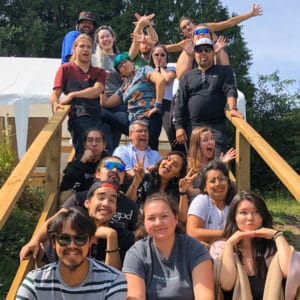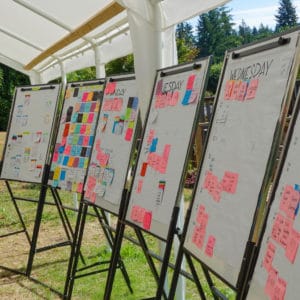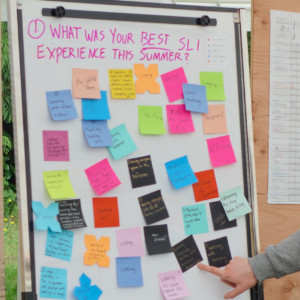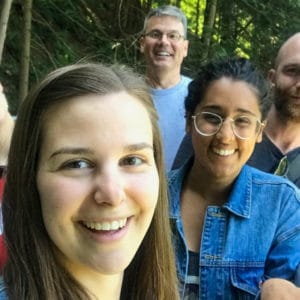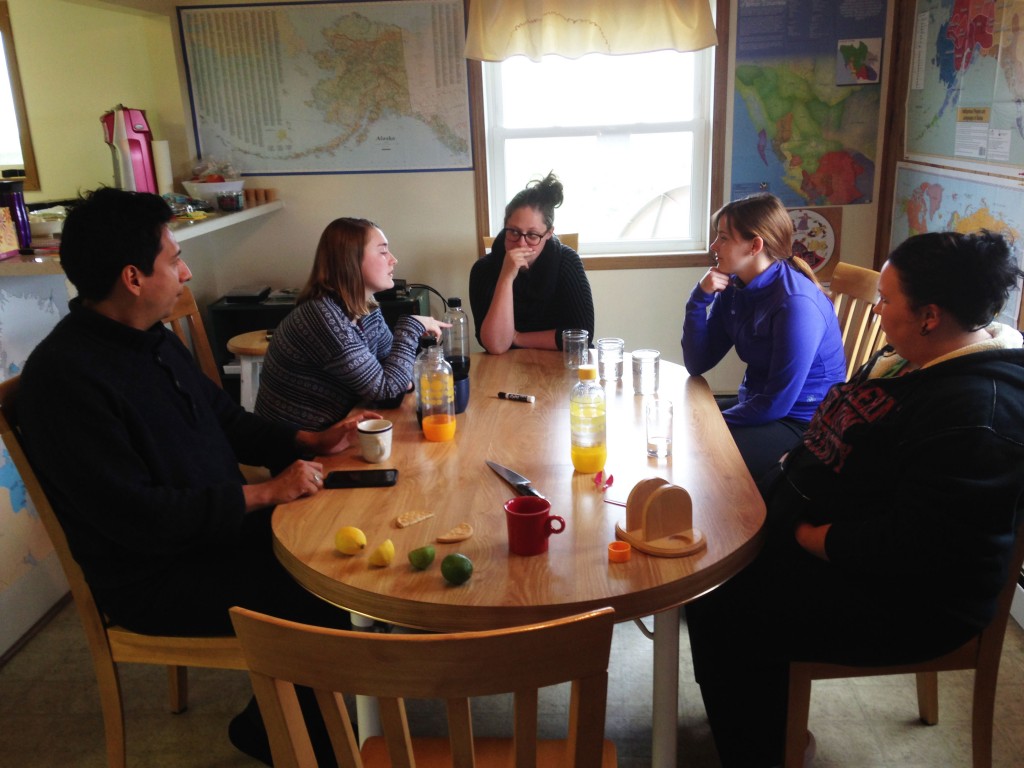
When we signed up to be interns with WAYK we really had no idea what we were actually getting ourselves into…in a good way. It’s next to impossible to explain in a two hour interview or one hour teleconference what you do for 18ish hours a day, 7 days a week, while living in a small house revitalizing a language in a remote Alaskan community. We’ve been here for about three weeks now and we’re still not sure that we even completely understand what all we do and we certainly can’t explain it in any sort of coherent way.
One thing that we do a lot of unsurprisingly is language. And we say we do language because we really mean that we “do” it. Although sometimes it is both necessary and interesting to talk about language and how we can help revitalize languages in a theoretical sense, it’s often more interesting and more productive to just do it. So one thing that we as a WAYK team are doing this summer is swapping languages that we speak. In particular we are focusing on teaching/learning chinuk wawa, which is essentially contributing to the revitalization of chinuk wawa. Evan, Susanna, and Sky are all speakers of chinuk wawa at varying levels of fluency and they are teaching it to us (Casey and Robyn).
Susanna and Sky learned chinuk wawa from Evan who learned it from Tony Johnson, Bobby Mercier, and Henry Zenk (who learned from Wilson Bob) amongst other speakers. The chinuk wawa we are learning is a specific dialect from the Confederated Tribes of Grand Ronde.
We’re learning to use the WAYK method which includes hunting, techniques, setups, and, of course, not translating. We have been learning for about 2 weeks and are both at around 10 hours of time in chinuk, which is being tracked basically by the minute. This weekend we were given our first practice oral proficiency interview to check our fluency modeled after the ACTFL scale. Of course it’s not official but it can give us an idea of how far we’ve gotten, but according to Evan we’re doing great! And really we are guinea pigs for tracking how fluent we can get in a summer using WAYK. So far our learning chinuk has been more hands-on than anything either of us have ever done to learn a language. Sometimes after a day of working on Unangam Tunuu lesson-building and hunt planning and other awesome, exciting things going on in St. Paul, we walk back to the house with Sky and talk about the things and people we see, or what we are currently doing. More than once we have completely stopped in the middle of the road because we can’t walk and think about a setup at the same time. At home, Evan has dragged us into the freezing (40º Fahrenheit/10º Celsius and windy, i.e. not actually that cold unless you’re a wimp like we are) great outdoors so we can hunt chinuk from him. We also take little opportunities to attempt what we want to say in chinuk when we think we have enough language to get it close.
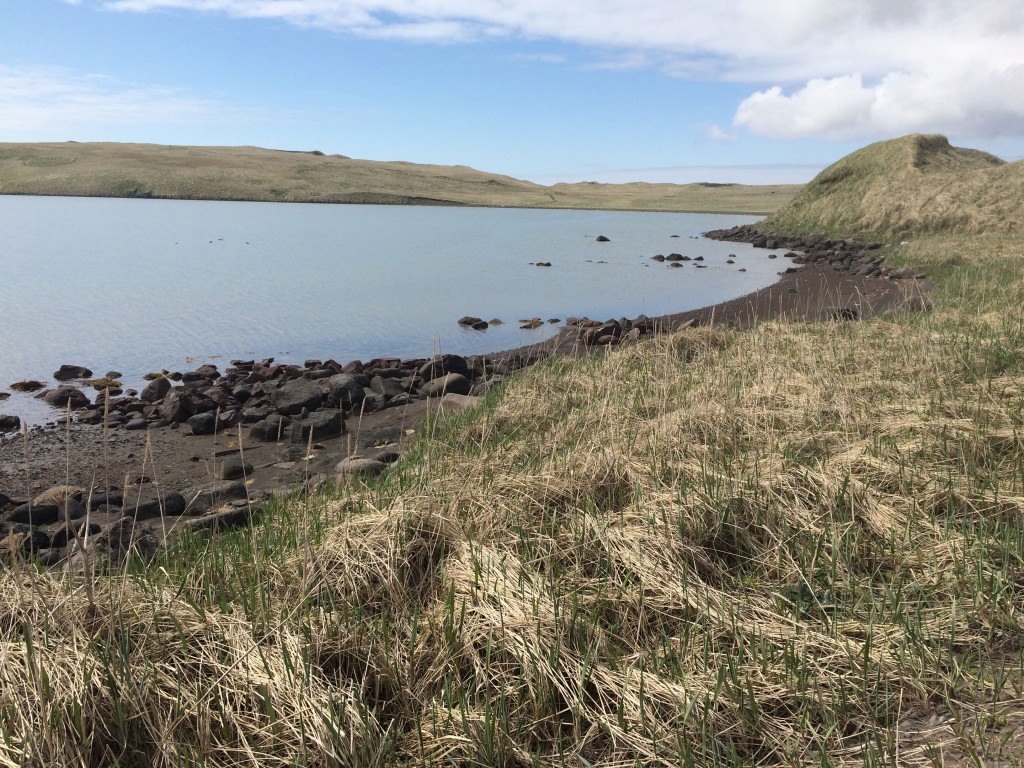
So now, at the beginning of our chinuk journey, we feel that the place to start our chinuk story is how we got here. Below, both of us describe a bit of our experience with other languages.
Robyn:
I have always had an interest in language but never had much success with learning other languages. My Mom’s family is from Germany and my Mom, grandparents, and great Aunts and Uncles are fluent in German so I grew up hearing German being spoken but never really learned anything except for how to say Merry Christmas and Happy New Year to my Grandma at Christmas time. Since I grew up in Canada I also learned French in school as a mandatory subject until grade six, and then continued learning French to fulfill my language requirement in junior high and high school. Learning a language in a classroom is definitely more focused on grammar and writing though so while my writing and reading French abilities were strong I was never a great French speaker, and then when school ended and I had no reason to practice I lost all my French skills and now I’m not good at speaking, listening, reading, or writing.
In university I found a way to study languages without ever actually learning a language, which meant that I majored in linguistic anthropology, and learned how to study languages. Most of my classes centered around the connection between language, culture, and identity, which included topics like language endangerment, revitalization, and classification. I also took some more technical linguistic courses studying phonology, morphology, and syntax. The closest I’ve come to learning a language in my university career is when I began a Master’s degree and working with a language community in Ghana to document the phonology of the language and help develop an orthography for the language. This was a pretty technical project though so I mostly studied the sounds of the language and learned a lot of vocabulary because I was interviewing speakers who translated word lists so did not actually get anywhere near fluent. In fact, I can name almost every animal, plant, food, and household object in Nabit, but pretty well the only sentences I can say are greetings, introductions, and things like “today I eat rice” and “tomorrow you eat rice”. Certainly if I go back to Ghana and work more on the project I will get more fluent, but in the six weeks I was in Ghana last summer (May/June 2014) that’s all the progress I made. So basically to sum it up at this point I’m a monolingual English speaker with a minimal knowledge of Nabit and deep in the storage files of my brain is probably some understanding of French.
Casey:
As a college student who also happens to major in linguistics, I’ve now had a variety of language learning experiences. First was my high school French class which, while probably landing itself a spot in the lower tier of high school language courses quality-wise, was still a fairly standard high school language course. Generally, it involved a lot of looking at a bored teacher pointing at a blackboard and learning to explain “No, I do not like to play tennis,” for weeks on end, a phrase that the class learned because it was directly translated, word by word.
Next for me were my much more enjoyable American Sign Language courses at the University of Virginia, notable to me for never, ever making use of spoken English as well as including an exceptional Deaf culture component. This course used a lot of pictures of concepts for which we learned ASL signs, which was a giant step closer to the WAYK method of set ups and avoidance of fairy-killing.
My most recent exposure to a new language prior to joining WAYK this summer was in a linguistics course where I had my first taste of linguistic field methods, with an Arapesh speaker from Papua New Guinea as our guest twice a week. In this class, because our speaker was a quite fluent English speaker, much of our data came from direct translation. We often attempted to string together a sentence on our own, but nearly everything we recorded was confirmed by his best estimation of its English equivalent. As a linguistics student who didn’t have nearly enough time to get fluent in Arapesh before beginning to describe its structure, this felt like the best option at the time. Unfortunately, like Robyn, my actual knowledge of the language is quite limited to simple phrases, and some impractical knowledge (at least when it comes to actively speaking it) of the sound and noun class systems.

